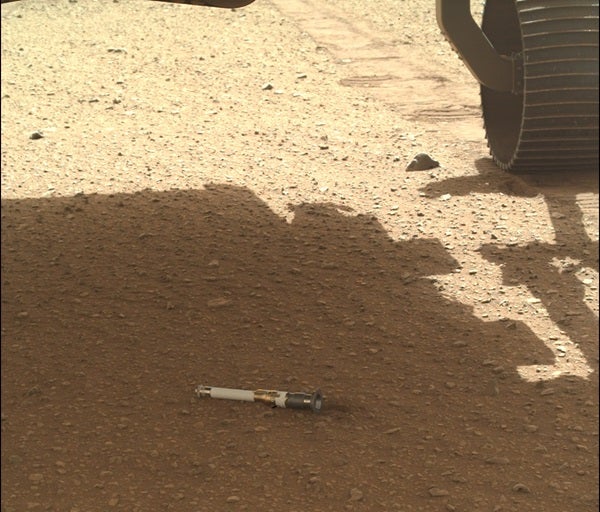The first of 17 titanium tubes currently filled with Mars’ material collected by the Perseverance rover is now safely resting on the surface of the Red Planet. It will eventually be joined by nine other tiny, light-saber-shaped tubes packed with chalk-sized cores of martian rocks and soil. Collectively, these tubes will form one of several planned cache depots that may eventually be selected for a return trip to Earth.
“Choosing the first depot on Mars makes this exploration campaign very real and tangible,” David Parker, ESA’s director of Human and Robotic Exploration, said in an ESA release. “Now we have a place to revisit with samples waiting for us there.”
Perseverance collected this sample from an igneous rock nicknamed “Malay,” located in a region of Jezero Crater called South Séítah, on Jan. 31, 2022.
While testing how Perseverance would drop its sample tubes on Earth, engineers found that the tubes would occasionally — less than 5 percent of the time — land upright after falling the roughly 3 feet (89 centimeters) from the rover’s belly to the ground. Should a tube land vertically on Mars, the mission team plans to carefully knock it over with Perseverance’s arm.
NASA/JPL-Caltech
Over the next two months, humanity’s first depot site on another planet — at a location called “Three Forks” — will grow to hold 10 total sample tubes. If Three Forks is ultimately chosen as the target of NASA/ESA’s Mars Sample Return campaign, planned for launch in the late 2020s, Perseverance would pick up and load the samples onto a robotic lander, which would pack them into a small return rocket. (A pair of Ingenuity-like helicopters would serve as retrieval backups should Perseverance not be up to the task.)
The small rocket would then launch the samples to Mars orbit for collection by an orbital spacecraft. After collection, they would begin their journey to Earth so that scientists could scrutinize the samples with some of the most advanced laboratory equipment in the world.
“Seeing our first sample on the ground is a great capstone to our prime mission period, which ends on Jan. 6,” Rick Welch, Perseverance’s deputy project manager at JPL, said in a NASA news release. “It’s a nice alignment that, just as we’re starting our cache, we’re also closing this first chapter of the mission.”
If all goes according to plan, the first batch of rock and soil plucked straight from Mars surface is expected to arrive on Earth in 2033.
“The first depot of Mars samples can be considered as a major risk mitigation step for the Mars Sample Return campaign,” Parker in the ESA release.
NASA/JPL-Caltech










